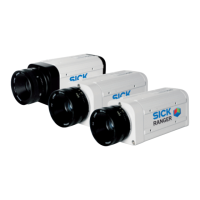Chapter 5 Reference Manual
Ranger E/D
56 ©SICK AG • Advanced Industrial Sensors • www.sick.com • All rights reserved
Configuring Ranger E and D
Using the encoder to trigger profiles will keep the distance between profiles constant.
Embedding encoder information (extended mark data) in the profiles will provide the
necessary information to calculate the appropriate compensation for each scan.
The distance to shift the color channels also depends on the distance between the camera
and the object. Objects closer to the camera get a higher relative speed of movement over
the sensor, causing the proper shift parameters to decrease, and vice versa.
To achieve the best results over the whole FOV, the registration parameters should be
determined in the middle of the depth of field.
Determining Registration Parameters
The registration parameters can be found either by trial and error, or by recording and
analyzing data, for example by using the example program provided with the development
software.
To obtain good registration parameters, the following is recommended:
Use a black and white object with high frequency content, for example a page of text.
When recording data, either make sure that the acquisition is triggered by an encoder,
that the acquired data contains mark data, or that the object speed is constant and the
same as in the final application.
A set of registration parameters can, if encoder marking is used, work with different scan
speeds but it will only work in one scan direction. If the scan direction is changed the
parameters need to be inverted as described below
Registering Color Channels
The iCon API contains a color registration filter that will perform the registration of the color
channels, using the registration parameters as input. Ranger Studio uses this filter to
display registered, compound color images.
The color registration filter interprets the values of the registration parameters differently,
depending on whether the color data contains extended mark data or not:
If extended mark data is available in the color data, the registration parameters are
interpreted as a number of encoder ticks, and the filter can handle speed variations.
If no mark data or normal mark data is available, the registration parameter values are
interpreted as a number of scans, and no speed variations can be handled.
Note that typically one of the color channels is the reference, and the registration parame-
ter is 0 for this channel. The other channels should have positive parameter values that
state how many scans earlier the respective sub-components should be sampled. If the
scan direction is reversed the shift parameters also change so that
[0,X, Y ] -> [Y,(Y-X),0].
Since the distance between the red and blue filters is half that of the distance between the
red and green the blue shift is typically twice that of the green shift, i.e. Y = 2X in the
example above.
5.10 Calibration
Calibration of range data refers to the process of turning sensor coordinates (pixel posi-
tions) into real-world coordinates (e.g. mm or inches). The 3D Cameras deliver range
profiles in terms of sensor positions rather than in mm or inches. By using the calibration
functions of iCon you can translate sensor positions into real-world coordinates. The image
below shows the relation between sensor positions and real world coordinates. Note that
in this chapter, sensor positions are always denoted by a (u,v) pair where u denotes the
sensor column and v is the sensor row. (u and v coordinates may be floating point num-
bers as the laser position is estimated on a sub-pixel level). Real world coordinates are
always denoted by (x, y, z) triplets or (x, z) pairs where x is the horizontal position in the
laser plane, y is the position along the direction of motion and z is the vertical position.
There is also a coordinate denoted r which is the distance from the origin of the coordinate
system and upwards in the laser plane. All calibration is done in the laser plane which
means the result is a translation between (u, v) and (x, r). If the laser plane is perpendicu-
lar to the reference plane (XY plane) this is equal to a translation between (u, v) and (x, z)
but if not you need to compensate for the skewed coordinate system. This is currently not

